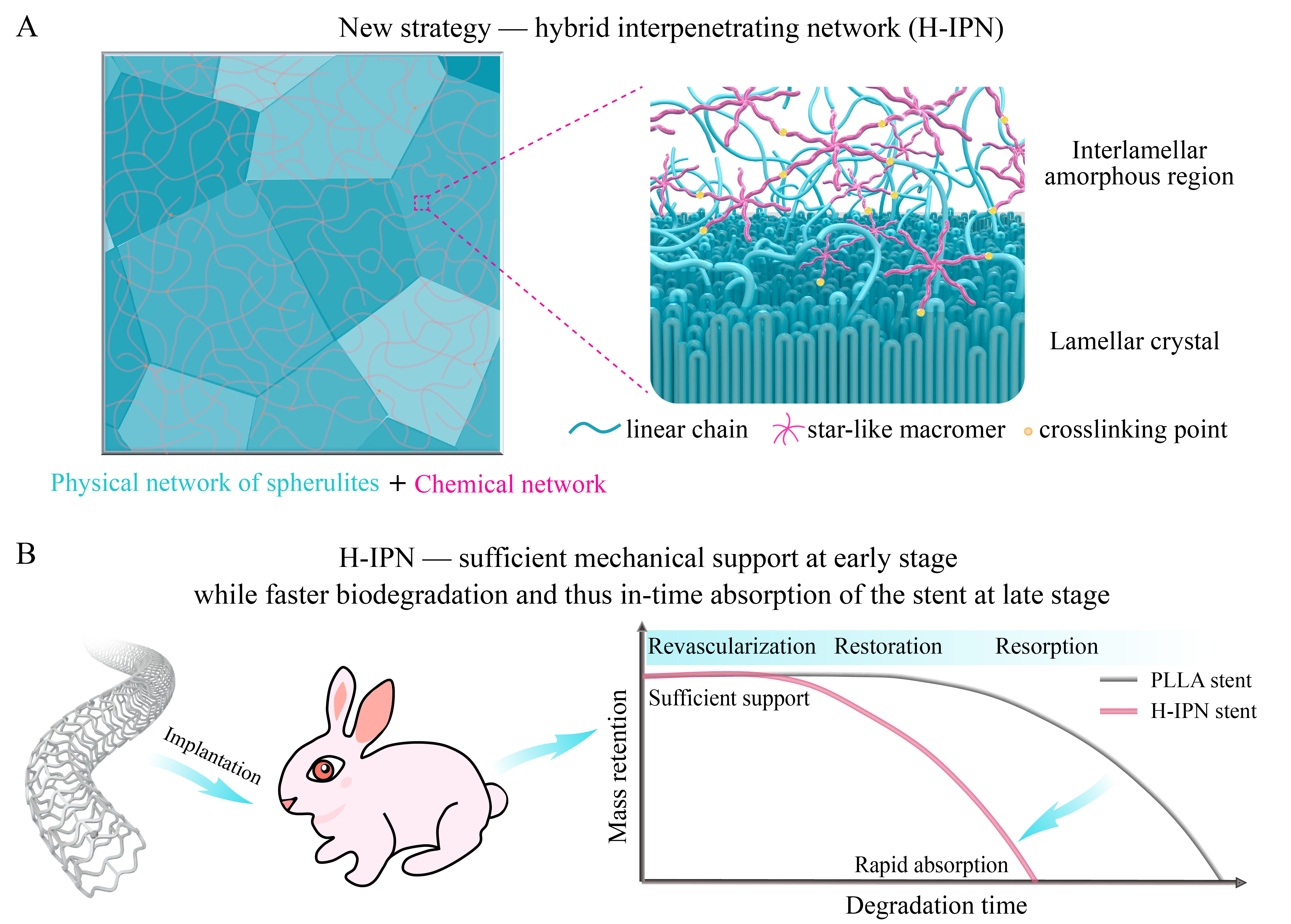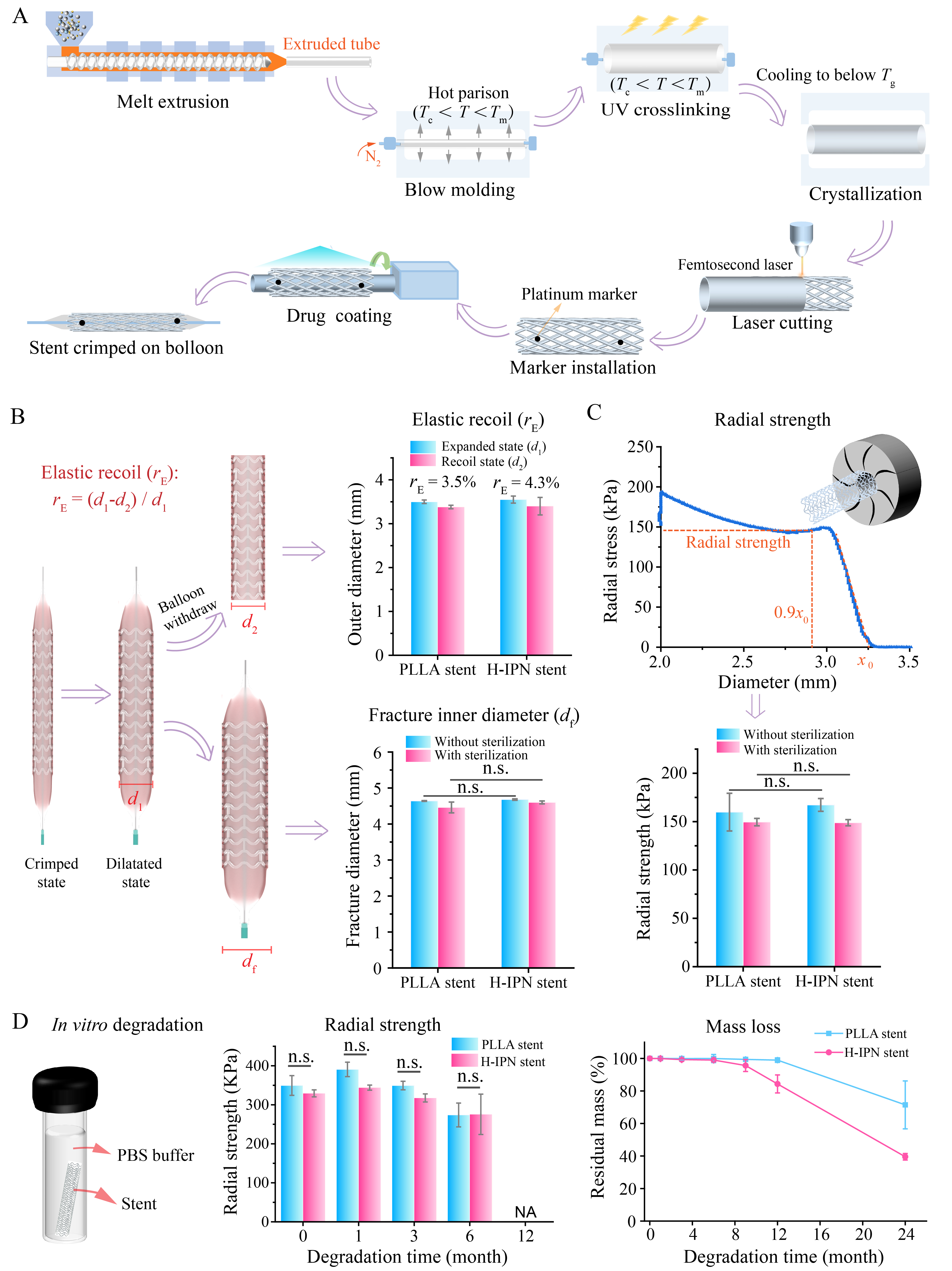 +565 975 658
+565 975 658
 info@premiumcoding.com
info@premiumcoding.com
 Monday - Friday, 8.00 - 20.00
Monday - Friday, 8.00 - 20.00
Percutaneous coronary intervention (PCI) has been the main therapeutic way to deal with coronary artery disease. Poly(L-lactide) (PLLA) is an important candidate raw material of the biodegradable coronary stent, but the degradation periods of mainstream PLLA coronary stents are more than 3 years, and the patients need long-term dual antiplatelet therapy combined aspirin with a platelet P2Y12 receptor inhibitor after stent implantation, which increases the cost and raises the potential risk of bleeding for patients, and also significantly increases the clinical cost of enterprises because of long-term clinical follow-ups. Over the years, some techniques have been tried to shorten the degradation of PLLA, but these always lead to the decrease of radial strength for PLLA-based stents, and thus are less industrial value. To make a polyester stent with sufficient mechanical strength and relatively fast biodegradation gets to be a dilemma. How can the appropriate biodegradation rate be achieved without loss of mechanical strength? This has been a challenging problem in the field of polyester coronary stent.
In this study, Jiandong Ding’s research group at Fudan University has, in collaboration with Jiang’s research group at MicroPort company, proposed a hybrid interpenetrating network (H-IPN) strategy in the formulism of molecular engineering of polymers. The team combines a linear aliphatic polyester with crosslinked aliphatic polyester with the basic idea of H-IPN schematically presented in Fig. 1. Firstly, they designed and synthesized a six-arm star-like poly(D,L-lactide-co-ɛ-caprolactone) (PLCL) macromer, and then blended PLLA with the PLCL macromer; next, the mixture was crosslinked by UV light; finally, the semi-crosslinked biodegradable polyester material was prepared after cooling crystallization. The resultant H-IPN polyester maintained sufficient mechanical strength, realizing a more appropriate biodegradation rate.

Fig. 1. The basic idea to develop a hybrid interpenetrating network (H-IPN) stent to deal with coronary artery stenosis.
The H-IPN material includes a physical network of spherulites and a chemical crosslinking network, and the chemically crosslinking network in the H-IPN may be distributed in the amorphous region of spherulites, and permeated into the spherulite network. The formation process of the H-IPN material depends on a designed sequence of time and temperature. The formation of the chemically crosslinked networks requires the temperature below the melting temperature Tm of linear PLLA, but above its crystallization temperature Tc. Then, no crystallization occurs at the initial stage, and chain segments of polymers have strong mobility, easy to realize sufficient crosslinking. The photoinitiating was triggered by UV light, and the photoinitiated free radical polymerization and hydrogen abstraction reaction jointly led to the formation of an interpenetrated network between PLCL and PLLA chains (Fig. 2).

Fig. 2. Gel content to reflect the crosslinking efficacy.
AfterUV light crosslinking, the material cooled naturally and gradually formed spherulite networks (Fig. 3), and the crosslinking network was squeezed out of the crystalline region. Eventually, a hybrid interpenetrating network (H-IPN) was formed, where the chemically crosslinking network was distributed in the amorphous region of spherulites. Owning to the preformed chemical crosslinking network, the crystallization process of H-IPN material was relatively limited and the crystallization rate was slower than that of PLLA, resulting in less perfect spherulites in the H-IPN material. The less perfect spherulites shortened the degradation period from 3 years to 2 years, meanwhile the chemical crosslinking networks compensated the mechanical strength, ensuring that the H-IPN material has sufficient mechanical strength compared to the conventional PLLA.

Fig. 3. The physical network of spherulites of H-IPN.
The Ding team employed this H-IPN strategy to fabricate a semi-crosslinked and semi-crystalline biodegradable polyester coronary stent after combining the pipe blow-molding and laser cutting processing technologies. The manufacturing process of the H-IPN stent contained, compared to that of the PLLA stent, only one additional step (UV irradiation) during blow molding (Fig. 4), which is facile and controllable to achieve the continuous and mass production. The product exhibited similar key performances including elastic recoil, fracture inner diameter of radial expansion and radial strength to the classic PLLA stent, and even higher radial strength has been achieved by adjusting the macromer and the degree of crosslinking. The H-IPN stent has realized faster yet more appropriate degradation, and meanwhile maintained sufficient mechanical support during biodegradation.

Fig. 4. Fabrication of H-IPN stents and the corresponding physiochemical evaluation. (A) Schematic diagram of the fabrication process of the H-IPN stent. (B) The performances of elastic recoil and radial expansion of H-IPN stent; (C) The radial strength of H-IPN stent. (D) The in vitro degradation of H-IPN stent.
The feasibility and safety of the H-IPN stent for interventional therapy have been validated by animal experiments, and some results are shown in Fig. 5. During the follow-up of 12 months, all the stented arteries kept well unobstructed, and the lumen diameters matched well with the original artery diameters. Vascular endothelialization was completed at about 3 months after implantation of the coronary stent, and no thrombosis occurred. The intravascular ultrasound (IVUS) and optical coherence tomography (OCT) images indicate that very obscure struts of the H-IPN stent were observed at 9 months after implantation, while the struts of the PLLA stent were clearly observed, which demonstrated that the H-IPN stent degraded significantly faster than the PLLA stent. The restenosis rate of the H-IPN stent is well below the acceptable criterion throughout the follow-ups.

Fig. 5. OCT observations of stented blood vessels. (A) The degradation of the PLLA stent and the H-IPN stent. (B) The area stenosis of the rabbit aorta abdominalis calculated from OCT images 6, 9 and 12 months after implantation of the PLLA stent and the H-IPN stent.
In summary, the concept of H-IPN has been put forward. A series of polymer chemistry, polymer physics, polymer processing, in vitro and in vivo biological assessments of medical devices, and the interventional implanting into aorta abdominalis of rabbits and the follow-ups have confirmed the safety and efficacy of the H-IPN stent. Different from the conventional interpenetrating network, the term “hybrid” in this H-IPN strategy, proposed based on molecular engineering of polymers, is reflected from three aspects: (1) combination of a chemically crosslinked network and a physically percolated spherulite network; (2) blending of linear PLLA and polymerized multifunctional copolyester macromer; (3) crosslinking between the macromer network and a part of the initial linear polymer chains owing to radical transfer triggered by the “side reaction” of the photoinitiation, resulting in a significant increase in the gel content. The H-IPN strategy is stimulating for regulation of polymeric material systems with tunable mechanical properties and degradation rates, and provides a new direction for the design and development of the next generation of biodegradable coronary artery stents.
The article entitled "Hybrid interpenetrating network of polyester coronary stent with tunable biodegradation and mechanical properties" was published in Biomaterials, a leading professional journal in the field of biomaterials. The first author is Mr. Daokun SHI, a Ph. D candidate at the State Key Laboratory of Polymer Molecular Engineering at Fudan University. One of the corresponding authors is his supervisor Prof. Jiandong DING, who is the director of the State Key Laboratory of Polymer Molecular Engineering and a distinguished professor of Fudan University, and another corresponding author is Dr. Hongyan JIANG, a vice president of Microport.
Article link: https://www.sciencedirect.com/science/article/pii/S0142961223004192
Get to know us better now!

Wechat:FDUMMers
Search!
Search across our website
Revenant @ 2018 by fudan | All Rights Reserved
Powered by Weicheng

